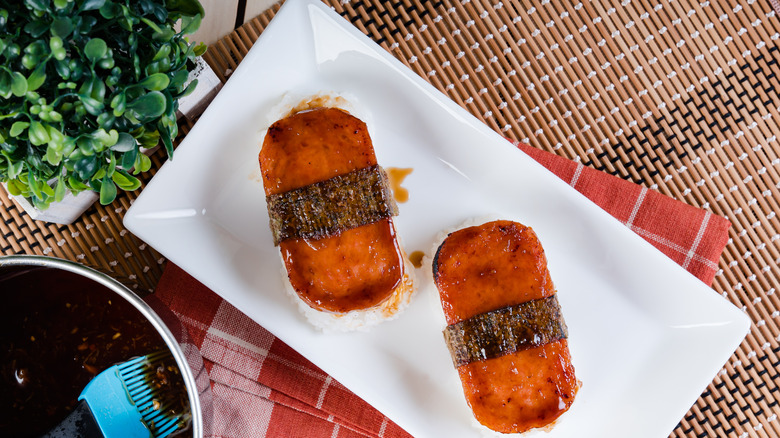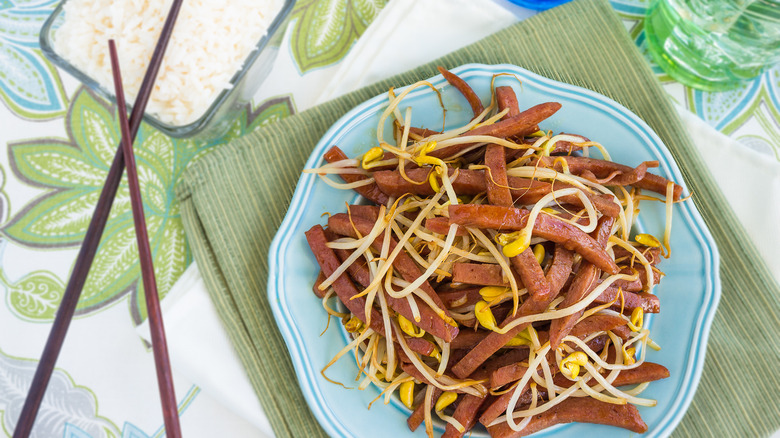World War II Played An Important Role In SPAM's Popularity In Hawaii
SPAM can be decidedly divisive — it's either loved or loathed. According to Food Network, its recipe has barely changed since 1937 — and it does not, as it's commonly rumored, contain any mystery meat; the brand's website reveals its six ingredients: pork (shoulder and ham), salt, water, potato starch, sugar, and sodium nitrate. As its eighty-six-year-run reveals, SPAM is here to stay — and if there are any doubts about its solid foothold in American food culture, know that many have tried incorporating flavorful varieties (there was even a limited run of pumpkin spice SPAM). As it turns out, when you open a humble can of SPAM, you're in for a major history lesson.
As reported by SPAM's parent brand, Hormel Foods began shipping vast quantities of shelf-stable SPAM products to troops fighting in World War II in the 1940s. Time adds that in some places, SPAM became synonymous with America's post-war recovery efforts. In England, the canned meat went from a welcome, inexpensive source of animal protein to the subject of ridicule — negative perceptions that still simmer. Time explains that today, Pacific Islander and Asian-American chefs have a complicated relationship with SPAM — and the processed pork is more popular in Hawaii than anywhere else (per SPAM Brand).
The connection between SPAM and Hawaii
In the Pacific, SPAM became inextricably linked to the American military and its aftermath — including occupation, food shortages and restrictions, and incarceration camps, as reported by Time — both a necessity and a constant reminder of hardship. When the war was over, SPAM had become part of local cuisine in parts of Southeast Asia and the Pacific, Hormel adds, including Hawaii. Medium various recipes combining SPAM with regional and American ingredients, like the Hawaiian specialty loco moco and saimin, a noodle soup, all made with SPAM.
But perhaps the most well-known SPAM dish nowadays is SPAM musubi. According to Time, SPAM musubi is attributed to a Japanese-American woman named Barbara Funamura, who lived in Hawaii. Medium describes the dish as a slice of fried Spam wrapped around a slab of pressed white rice with nori seaweed — similar to Japanese onigiri (rice balls) and coming in many subforms like egg and teriyaki versions. Food Network says you'll often find SPAM musubi studded with sesame seeds and served with a sugary soy sauce that complements its signature saltiness.
Hawaiian and homemade SPAM recipes
Today, SPAM can still be found throughout Hawaii — there's even a celebration dedicated to it in Waikiki, per Medium, and it's brilliantly called Spam Jam. The website reports that it's one of the state's best-rated food fests, listing participants' specials that feature SPAM in everything a foodie can dream of — from sandwiches, pasta, and burgers to tacos, nachos, gyros, cocktails, and Hawaiian specialties like poke bowls and of course, musubi. SPAM's a natural match with pineapple and perfect for topping Hawaiian pizza.
If you'd like to show SPAM musubi some love, you can make it at home for a fraction of the cost of a plane ticket to the Aloha State. Food Network has a traditional sweet and salty ham musubi from Molly Yeh, a furikake-filled, fully wrapped version, and a sushi-inspired Hawaiian shoyu musubi sweetened with brown sugar. SPAM is as user-friendly as it's always been — you can eat it right from the can — but you can also cook with it like any other meat, making it a versatile pantry ingredient to have on hand and deserving of a deeper understanding.


